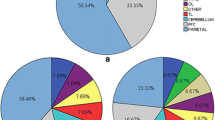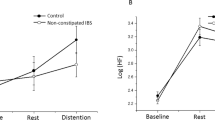Abstract
Previous studies have demonstrated alterations in brain response to rectal distension in patients with irritable bowel syndrome (IBS) compared to controls. Our aim was to compare regional brain activity in response to rectal balloon distension in patients with IBS and healthy controls. We studied six patients with IBS and six healthy controls. Positron emission tomography scans were obtained during rectal balloon distensions. Statistical parametric mapping and region of interest analysis were performed to identify and compare differences in regional cerebral blood flow (CBF) for each distension pressure within and between the groups of interest. In post-hoc analyses, patients with a history of sexual or physical abuse were compared to patients without abuse. In response to rectal distension, controls exhibit a greater increase in anterior cingulate cortex (ACC) activity compared to the IBS group (Z = 3.2, P = 0.001). Thalamic activity was higher in the IBS patients relative to the control group (Z = 3.3, P < 0.001). Increased ACC activity was observed in IBS patients with no history of abuse (Z = 5.2, P < 0.001) similar to controls, whereas no such increased activity was noticed in the abused group. In conclusion, this study replicates previous findings showing alterations in brain response to rectal distension in patients with IBS. The observations on the effect of abuse suggest a possible modulating role of abuse history on this brain response.
Similar content being viewed by others
REFERENCES
Derbyshire SWG: Meta-Analysis of thirty-four independent samples studied using positron emission tomography reveals a significantly attenuated response to noxious stimulation in clinical pain patients. Curr Rev Pain 3(4):265–280, 1999
Vogt BA, Derbyshire S, Jones AKP: Pain processing in four regions of human cingulate cortex localized with co-registered PET and MR imaging. Eu J Neurosci 8:1461–1473, 1996
Derbyshire SWG, Jones AKP, Gyulai F, Clark S, Townsend D, Firestone L: Pain processing during three levels of noxious stimulation produces differential patterns of central activity. Pain 73: 431–445, 1997
Vogt BA, Sikes RW: The medial pain system, cingulate cortex, and parallel processing of nociceptive information. Prog Brain Res 122:223–235, 2000
Aziz Q, Andersson R, Valind S, Sundin A, Hamdy S, Jones AKP, Foster E, Langstrom B, Thompson DG: Identification of human brain loci processing esophageal sensation using positron emission tomography. Gastroenterology 113:50–59, 1997
Ladabaum U, Minoshima S, Hasler WL, Cross D, Chey WD, Owyang C: Gastric distension correlates with activation of multiple cortical and subcortical regions. Gastroenterology 120:369–376, 2001
Silverman DH, Munakata JA, Ennes H, Mandelkern MA, Hoh CK, Mayer EA: Regional cerebral activity in normal and pathological perception of visceral pain. Gastroenterology (1)112:64–72, 1997
Ringel Y, Drossman DA: From gut to brain and back—a new perspective into functional gastrointestinal disorders. J Psychosom Res 47(3):205–210, 1999
Mayer EA, Gebhart GF: Basic and clinical aspects of visceral hyperalgesia. Gastroenterology 107:271–293, 1994
Aziz Q, Thompson DG: Brain—gut axis in health and disease. Gastroenterology 114:559–578, 1998
Drossman DA: Presidential address: gastrointestinal illness and the biopsychosocial model. Psychosom Med 60:258–267, 1998
Drossman DA, Creed FH, Olden KW, Svedlund J, Toner BB, Whitehead WE: Psychosocial aspects of the functional gastrointestinal disorders. In Rome II. The Functional Gastrointestinal Disorders: Diagnosis, Pathophysiology and Treatment; A Multinational Consensus. DA Drossman, E, Corazziari NJ, Talley W, Thompson, WE, Whitehead (eds). McLean, Virginia, Degnon Associates 2000, pp. 157–245
Thompson GW, Longstreth GE, Drossman DA, Heaton KW, Irvine EJ, Muller-Lissner SA: Functional bowel disorders and functional abdominal pain. In Rome II. The Functional Gastrointestinal Disorders. Diagnosis, Pathophysiology and Treatment; a Multinational Consensus. DA, Drossman E, Corazziari NJ, Talley WG, Thompson WE, Whitehead (eds). McLean, Virginia, Degnon Associates, 2000, pp. 351–432
Chang L, Berman S, Mayer EA, Suyenobu B, Derbyshire S, Naliboff B, Vogt B, FitzGerald L, Mandelkern MA: The coexistance of fibromylgia alters rectal perception before and after sigmoidstimulation in female IBS (in press).
Naliboff BD, Derbyshire SWG, Munakata J, Berman S, Mandelkem MA, Chang L, Mayer EA: Cerebral activation in irritable bowel syndrome patients and control subjects during rectosigmoid stimulation. Psychosom Med 63(3):365–375, 2001
Silverman HE, Ennes J, Munakata J, Hoh C, Mandelkem MA, Blahd W, Melinkoff S, Mayer EA: Differences in thalamic activity associated with anticipation of recatal pain between IBS patients and normal subjects. Gastroenterology 108(4):A1006, 1995
Mertz H, Morgan V, Tanner G, Pickens D, Price R, Shyr Y, Kessler R: Regional cerebral activation in irritable bowel syndrome in control subjects with painful and nonpainful rectal distention. Gastroenterology 118:842–848, 2000
Drossman DA, Leserman J, Nachman G, Li K, Gluck H, Toomey TC: Sexual and physical abuse in women with functional or organic gastrointestinal disorders. Ann Intern Med 113:828–833, 1990
DeGrado TR, Turkington TG, Williams JJ, Stearns CW, Hoffman JM, Coleman RE: Performance characteristics of a whole-body PET scanner. J Nucl Med 35:1398–1406, 1994
Friston KJ, Holmes AP, Worsley KJ, Poline JB, Frith CD, Frackowiak RSJ: Statistical parametric maps in functional imaging: a general approach. Hum Brain Mapping 2:189–210, 1995
Whitehead WE, Palsson OS: Is rectal pain sensitivity a biological marker for irritable bowel sydrome: psychological influences on pain perception. Gastroenterology 115(5):1–10, 1998
Mayer EA: Emerging disease model for functional gastrointestinal disorders. Am J Med 107:12S-19S, 1999
Bushnell MC: Thalamic processing of sensory-discriminative and affective-motivational dimensions of pain. In Forebrain Areas Involved in Pain Processing. JM, Bensson G, Guilband H, Ollat (eds). Paris, Libbey Eurotext, 1995, pp. 63–77
Rainville P, Duncan GH, Price DD, Carrier B, Bushnell MC: Pain affect encoded in human anterior cingulate but not somatosensory cortex. Science 227:968–971, 1997
Melzack R, Casey KL: Sensory, motivational, and central control determination of pain: a new conceptual model. In The Skin Senses DR Kenshalo (ed). Thomas, Springfield, Illinois 1968, pp. 423–439
Frankenstein UN, Bernstein C, Richter W, Sweetland C, McIntyre M: Functional imaging of visceral sensation and pain in patients with gastrointestinal disorders. Gastroenterology 116(4):A592, 1999
Villringer A: Understanding functional neuroimaging methods based on neurovascular coupling. Adv Exp Med Biol 413:1977–1993, 1997
Jones AP, Hughes DG, Brettle DS, Robinson L, Sykes JR, Aziz Q, Hamdy S, Thompson DG, Derbyshire SW, Chen AC, Jones AK: Experiences with functional magnetic resonance imaging at 1 tesla. Br J Radiol 71:160–166, 1998
Muller-Gartner HW Imaging techniques in the analysis of brain function and behaviuor. Trends Biotechnol 16(3):122–130, 1998
Dettmers C, Connelly A, Stephan KM, Turner R, Friston KJ, Frackowiack RS, Gadian DG: Quantitative comparison of functional magnetic resonance imaging with positron emission tomography using a force-related paradigm. Neuroimage 4:201–209, 1996
Vogt BA, Finch DM, Olson CR: Functional heterogeneity in cingulate cortex: the anterior executive and posterior evaluative regions. Cerebral Cortex 2:435–443, 1992
Vogt BA: Structural organization of cingulate cortex: areas, neurons, and somatodentric transmitter receptors. In BA, Vogt M, Gabriel (eds). Neurobiology of Cingulate Cortex and Limbic Thalamus. Boston, Birkhauser, 1992, pp. 19–70
Devinsky O, Morrell MJ, Vogt BA: Contributions of anterior cingulate cortex to behavior. Brain 118:279–306, 1995
Mayer EA, Derdyshiere S, Naliboff BD: Cerebral activation in irritable bowel syndrom. Gastroenterology 119(5):1418, 2000
Drossman DA, Li Z, Leserman J, Toomey TC, Hu Y: Health status by gastrointestinal diagnosis and in relation to abuse history Gastroenterology 110:999–1007, 1996
Bremner JD, Randall P, Vermetten E, Staib L, Bronen RA, Mazure C, Capelli S, McCarthy G, Innis RB, Charney DS: Magnetic resonance imaging-based measurement of hippocampal volume in posttraumatic stress disorder related to childhood physical and sexual abuse. A preliminary report decreased hippocampal mass. Biol Psychiatry 41;23–32, 1997
Bremner JD, Randall P, Scott TM, Bronen RA, Seibyl JP, Southwick SM, Delaney RC, McCarthy G, Charney DS, Innis RB: MRI-based measurement of hippocampal volume in patients with combat-related posttraumatic stress disorder. Am J Psychiatry 152(7):973–981, 1995
Stein MB, Koverola C, Hanna C, Torchia MG, McClarty B: Hippocampal volume in women victimized by childhood sexual abuse. Psychol Med 27(4):931–959, 1997
Shin LM, McNally RJ, Kosslyn SM, Thompson WL, Rauch SL, Alpert NM, Metzger LJ, Lasko NB, Orr SP, Pitman RK: Regional cerebral blood flow during script-driven imagery in childhood sexual abuse-related PTSD: a PET investigation. Am J Psychiatry 156(4):575–584, 1999
Rights and permissions
About this article
Cite this article
Ringel, Y., Drossman, D.A., Turkington, T.G. et al. Regional Brain Activation in Response to Rectal Distension in Patients with Irritable Bowel Syndrome and the Effect of a History of Abuse. Dig Dis Sci 48, 1774–1781 (2003). https://doi.org/10.1023/A:1025455330704
Issue Date:
DOI: https://doi.org/10.1023/A:1025455330704




